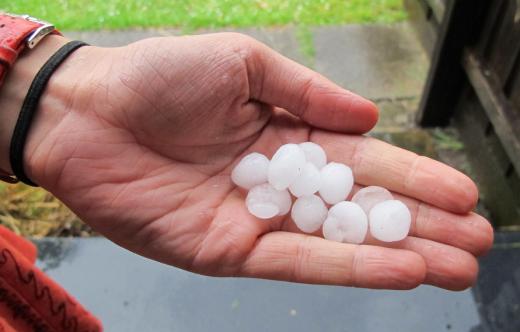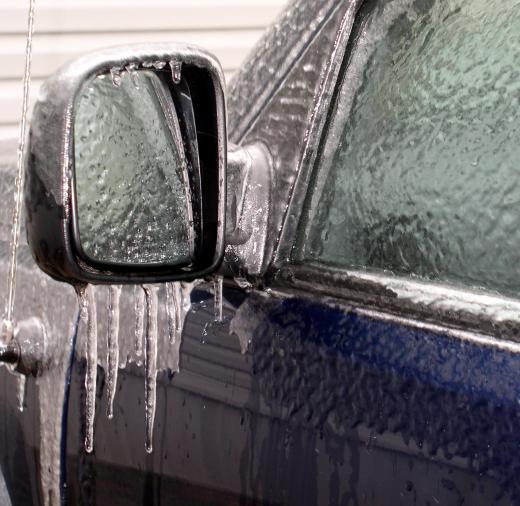What is Freezing Rain?
 Mary McMahon
Mary McMahon
Freezing rain is rain which consists of supercooled droplets of water which freeze upon impact with objects on the surface of the Earth. This meteorological phenomenon can be quite dangerous, especially for planes and cars, and it can cause substantial economic damage. If freezing rain is prolonged, it can lead to the development of an ice storm, which may cut power in addition to making roads impossible to navigate.
This type of rain usually forms at the point where a warm front and a cold front meet. Snow starts to fall from the cold front, passing through a pocket of warm air and melting into water droplets. When the water droplets hit cold air near the Earth's surface, they become supercooled, meaning that their temperature descends below freezing, but they do not become solid. When the supercooled droplets hit something, they ice over immediately. Conditions have to be just right for freezing rain to form. If, for example, the pocket of cold air is deep, the droplets will freeze into solid ice pellets, and if the pocket of cold air is too shallow, the droplets will not supercool, and will therefore remain in liquid form when they hit the Earth.

One of the big problems with freezing rain is that it creates a layer of ice known as glaze. Glaze can quickly weigh down tree branches and power lines, causing them to snap, and it can also damage frost-sensitive plants. Additionally, glaze tends to cover bridges and roadways, making it difficult and dangerous to drive, and it can ice over the winds of aircraft, changing their shape and reducing the aerodynamics of the plane. If enough glaze accumulates, it can pull a plane right out of the sky.

Freezing rain is not the same thing as sleet, a mixture of snow and rain which can fall in the right weather conditions. This type of rain often occurs when there is snow on the ground, because if the snow is sticking, it means that surface temperatures are close to freezing, which creates optimal conditions for freezing rain, but snow does not have to present for it to form.

The conditions which cause freezing rain are well known and well understood. Using satellites and other tools to make observations, a meteorologist can often predict when it is likely to occur, and encourage communities to make preparations. Common preparations including issuing weather advisories to the public, alerting them to potentially dangerous conditions, and closing schools and public buildings so that people are not encouraged to travel during periods of freezing rain.
AS FEATURED ON:
AS FEATURED ON:















Discussion Comments
@turkay1-- I think they are both equally dangerous. My brother is a pilot and he says that it is difficult to fly even in heavy rain. It takes away from the power of the plane and makes it difficult to maneuver.
The drizzle drops should be smaller than freezing rain drops but in my view it doesn't make it less dangerous.
I heard that freezing rain and freezing drizzle are the worst nightmares of a pilot. But what's the difference between the two?
Drizzle is less rain right? So does that mean freezing drizzle is less dangerous for planes than freezing rain?
Thanks!
I live on the East Coast and I remember a weather center saying that the North Eastern part of the United States experiences the most freezing rain. I don't know what makes that true, maybe it's the effects of the ocean currents and winds.
But every time that there is freezing rain, even if it is for an hour or less, businesses and schools close here. It happened last year and life literally stopped for us for several days.
Post your comments